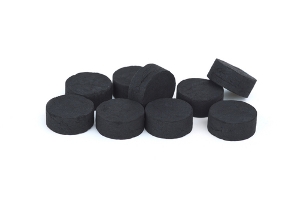 Activated carbon is a processed, porous version of carbon that has many different uses, especially adsorption and chemical reaction needs for water and gas purification. Because activated carbon particles are so porous, they have very expansive surface areas tucked into the holes and tunnels all over their surface. These areas can be filled with other materials for other purposes as well. For instance, in water purification, silver is mixed into the carbon pores in order to filter contaminants like mercury and organic arsenic from water for domestic drinking purposes. Because carbon is produced from charcoal through a relatively inexpensive and simple series of activation processes, it can be had in great quantities for many applications.
Activated carbon is a processed, porous version of carbon that has many different uses, especially adsorption and chemical reaction needs for water and gas purification. Because activated carbon particles are so porous, they have very expansive surface areas tucked into the holes and tunnels all over their surface. These areas can be filled with other materials for other purposes as well. For instance, in water purification, silver is mixed into the carbon pores in order to filter contaminants like mercury and organic arsenic from water for domestic drinking purposes. Because carbon is produced from charcoal through a relatively inexpensive and simple series of activation processes, it can be had in great quantities for many applications. The production process of activated, or active, carbon exists in two forms. A carbonaceous source, which can exist as coal, peat, or any organic carbonaceous material is carbonized, which means the pure carbon is extracted by a heating method known as pyrolysis. Once the material is carbonized, it needs to be oxidized, or treated with oxygen, either by exposure to CO2 or steam, or by an acid-base chemical treatment.
Carbonization
Carbonization is the process of taking a carbon-rich piece of material and converting it to pure carbon through heating. This heating process, called pyrolysis, comes from an ancient technique for making charcoal. Very dense carbonaceous material is used in the beginning, because the end result needs to be extra-porous for activated carbon purposes. Carbon-rich material is placed in a small (relative to the amount of material) furnace and cooked at extreme temperatures topping 2000 degrees Celsius. What remains is usually 20-30 percent of the beginning weight, and consists of mostly carbon and a small percentage of inorganic ash. This is very similar to “coking,” a method of producing coke from charcoal, a type of carbon-based fuel.
Once the porous form of carbon is produced, it needs to undergo oxidization so it can be adsorbent. This can occur in one of two ways: gas or chemical treatment.
Gas Treatment
The activizing of carbon can be done directly through heating in a chamber while gas is pumped in. This exposes it to oxygen for oxidization purposes. When oxidized, the active carbon is susceptible to adsorption, the process of surface bonding for chemicals—the very thing that makes activated carbon so good for filtering waste and toxic chemicals out of liquids and gases. For physical gas treatment, the carbonization pyrolysis process must take place in an inert environment at 600-900 degrees Celsius. Then, an oxygenated gas is pumped into the environment and heated between 900 and 1200 degrees Celsius, causing the oxygen to bond to the carbon’s surface.
Chemical Treatment
In chemical treatment, the process is slightly different from the gas activization of carbon. For one, carbonization and chemical activation occur simultaneously. A bath of acid, base or other chemicals is prepared and the material submerged. The bath is then heated to temperatures of 450-900 degrees Celsius, much less than the heat needed for gas activation. The carbonaceous material is carbonized and then activated, all at a much quicker pace than gas activization. However, some heating processes cause trace elements from the bath to adsorb to the carbon, which can result in impure or ineffective active carbon.
Post Treatment Activated Carbon
Following oxidization, activated carbon can be processed for many different kinds of uses, with several classifiably different properties. For instance, granular activated carbon (GAC) is a sand-like product with bigger grains than powdered activated carbon (PAC), and each are used for different applications. Other varieties include impregnated carbon, which includes different elements such as silver and iodine, and polymer coated carbons.
No comments:
Post a Comment